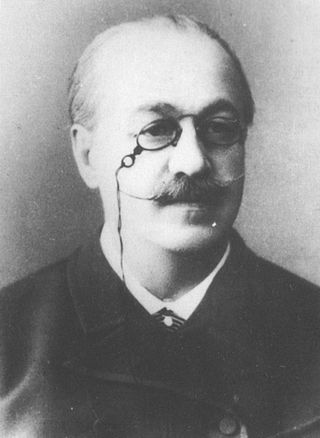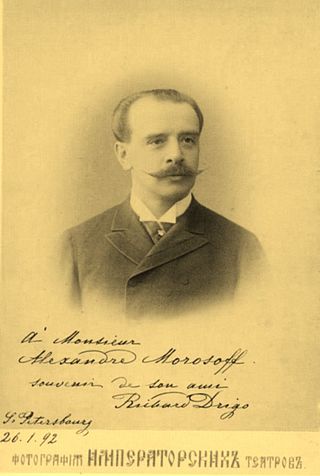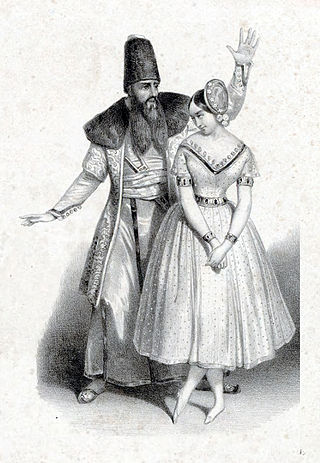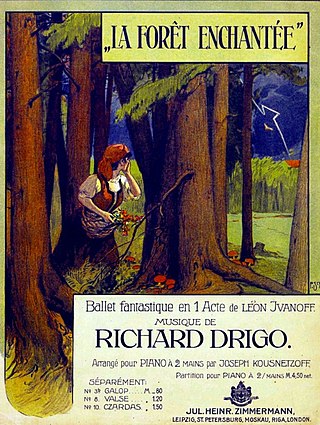Related Research Articles

Pierina Legnani was an Italian ballerina considered one of the greatest ballerinas of all time.

Marius Ivanovich Petipa, born Victor Marius Alphonse Petipa, was a French and Russian ballet dancer, pedagogue and choreographer. Petipa is one of the most influential ballet masters and choreographers in ballet history.
La Fille mal gardée is a comic ballet presented in two acts, inspired by Pierre-Antoine Baudouin's 1765 painting, La réprimande/Une jeune fille querellée par sa mère. The ballet was originally choreographed by the Ballet Master Jean Dauberval to a pastiche of music based on fifty-five popular French airs. The ballet was premiered on 1 July 1789 at the Grand Théâtre de Bordeaux in Bordeaux, France under the title Le ballet de la paille, ou Il n'est qu'un pas du mal au bien.

Lev Ivanovich Ivanov was a Russian ballet dancer and choreographer and later, Second Balletmaster of the Imperial Ballet. As a performer with the Imperial Ballet, he achieved prominence after performing as an understudy in a benefit performance of La Fille Mal Gardée. He is most famous as the choreographer of Acts II and IV of Swan Lake, which include the Dance of the Little Swans, Act II of Cinderella, and The Nutcracker, which he choreographed alongside Marius Petipa.

Riccardo Eugenio Drigo was an Italian composer of ballet music and Italian opera, a theatrical conductor, and a pianist.
The Sergeyev Collection is a collection of choreographic notation, musical materials, designs for décor and costumes, theatre programs, photos and other items that document the repertory of the Imperial Ballet of St. Petersburg, Russia at the turn of the 20th century. The majority of the choreographic notations document the original works and revivals of the choreographer Marius Petipa, who served as Premier Maître de ballet of the St. Petersburg Imperial Theatres. The collection also documents a few ballets by Lev Ivanov, who served as second Maître de ballet. Also included in the collection are choreographic notations documenting the choreography for the dances of various operas by both Petipa and Ivanov, respectively.
Camargo is a grand ballet in three acts and nine scenes, with choreography by Marius Petipa and music by Ludwig Minkus. The libretto by Jules-Henri Vernoy de Saint-Georges and Marius Petipa is based on an incident in the life of the 18th-century dancer Marie Camargo, in which she and her sister Madeleine were abducted by the Comte de Melun in May 1728 and taken to his mansion.

The Sacrifices to Cupid is a "grand ballet" in 1 Act/1 scene with choreography by Marius Petipa and music by Ludwig Minkus.
A Marriage During the Regency is a ballet in 2 acts, with libretto and choreography by Marius Petipa and music by Cesare Pugni.
The Parisian Market is a comic ballet in one act, with libretto and choreography by Marius Petipa and music by Cesare Pugni.
La Prima Ballerina, ou L'embuscade or The Traveling Dancer is a ballet in one act, with choreography by Marius Petipa, music by Cesare Pugni and libretto by Paul Taglioni. It was based on a ballet created by Paul Taglioni for the Ballet of Her Majesty's Theatre, London first presented on June 14, 1849.
Trilby is a ballet in 2 acts and 3 scenes, was the final ballet that Marius Petipa choreographed and staged for the Imperial Bolshoi Ballet during the two years that he was commissioned to create new works for the Moscow stage. And the music was by Yuli Gerber. Libretto by Marius Petipa, based on the 1822 novella Trilby, ou Le Lutin d'Argail by Charles Nodier, first presented by the Ballet of the Moscow Imperial Bolshoi Theatre on January 25/February 6, 1870, in Moscow with Polina Karpakova as Trilby and Ludiia Geiten as Miranda and restaged by Petipa for the Imperial Ballet at the Imperial Bolshoi Kamenny Theatre on January 17–29, 1871 in St. Petersburg with Adèle Grantzow as Trilby and Lev Ivanov as Count Leopold. Petipa made a more direct adaptation of Nodier’s novella.

The King's Command is a ballet in 4 Acts-6 Scenes, with choreography by Marius Petipa and music composed by Albert Vizentini.

La Tulipe de Haarlem is a fantastic ballet in three acts and four scenes, with choreography by Lev Ivanov and music by Baron Boris Fitinhoff-Schell, first presented by the Imperial Ballet on 16 October [O.S. 4 October] 1887 at the Imperial Mariinsky Theatre in St. Petersburg, Russia, with Emma Bessone, Pavel Gerdt, and Alfred Bekefy.

Le Réveil de Flore, is a ballet anacréontique in one act, with choreography by Marius Petipa and music by Riccardo Drigo, to a libretto written by Petipa and Lev Ivanov. First presented by the Imperial Ballet at Peterhof Palace on 6 August [O.S. 25 July] 1894.

Le Diable amoureux is a ballet-pantomime in three acts and eight scenes, originally choreographed by Joseph Mazilier to the music of Napoléon Henri Reber and François Benoist. The libretto by Jules-Henri Vernoy de Saint-Georges is based on Jacques Cazotte's 1772 occult romance The Devil in Love. The work was first presented by the Ballet of the Royal Academy of Music in Paris on 23 September 1840, with Pauline Leroux, Mazilier, and Louise Fitz-James.
Les Aventures de Pélée is a ballet in three acts and five scenes with choreography by Marius Petipa and music by Ludwig Minkus, with additional music adapted from works by Léo Delibes. The libretto by Marius Petipa is derived from the Greek Myth concerning the Goddess Thetis and the circumstances surrounding her marriage, arranged by Jupiter, to the mortal Peleus.

Anna Christianovna Johansson (1860–1917), was a Russian Empire ballerina who danced with the St. Petersburg Imperial Ballet.

La Forêt enchantée is a ballet fantastique in one act, originally choreographed by Lev Ivanov to the music of Riccardo Drigo, first presented by students of the Imperial Ballet School in St. Petersburg, Russia, at the school's theatre on 5 April [O.S. 24 March] 1887.
References
- ↑ Roland John Wiley (1997). The Life and Ballets of Lev Ivanov: Choreographer of The Nutcracker and Swan Lake. Clarendon Press. p. 219. ISBN 978-0-19-816567-5.